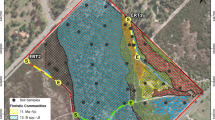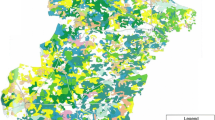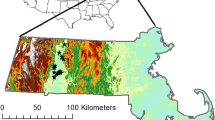Abstract
Inland Antarctic nunataks typically have simple physically weathered soils and limited ecosystem complexity. In this paper we present quantitative measurements of soil physical and chemical properties at one Antarctic nunatak. We measured pH, grain size, field capacity, soil organic carbon, phosphate, nitrate, ammonium and the cations magnesium, calcium and potassium along two transects. The data obtained indicated that very low levels of nutrients were present/available to biota, and that liquid water was absent, at least from the surface depths of soil, except during periods of active snow melt. Consequently, biological activity is severely limited. We conclude that, due to the climatic and microclimatic conditions at this location, the development of biological communities and soils is maintained in an extremely simple but still apparently stable ‘quasi climax’ state. Increased soil development and biological complexity can be expected if the contemporary rapid regional warming in the Antarctic Peninsula region continues.









Similar content being viewed by others
References
Arnold RJ, Convey P, Hughes KA, Wynn-Williams DD (2003) Seasonal periodicity of physical factors, inorganic nutrients and microalgae in Antarctic fellfields. Polar Biol 26:396–404
Beyer L, Blume HP, Bölter M, Kappen L, Kuhn D, Seppelt RD (2002) Soil ecology in relation to plant patterns. In: Beyer L, Bölter M (eds) Geoecology of Antarctic ice-free coastal landscapes. Ecological studies, vol 154. Springer, Berlin, pp 375–391
Beyer L, Bockheim JG, Campbell IB, Claridge GG (1999) Genesis, properties and sensitivity of Antarctic gelisols. Antarct Sci 11:387–398
Blume HP, Bölter M (1993) Soils of Casey Station, Antarctica. In: Gilichinski D (ed) Proceedings of 1st international symposium on cryopedol, Pushchino, Inst t Soil Sci Photosynth, Pushchino, pp 96–103
Blume HP, Bölter M (1996) Wechselwirkungen zwischen Boden- und Vegetationsentwicklung in der Kontinentalen Antarktis. Verh Ges Ökol 25:25–34
Blume HP, Kuhn D, Bölter M (2002) Soils and soilscapes. In: Beyer L, Bölter M (eds) Geoecology of Antarctic ice-free coastal landscapes. Ecological studies, vol 154. Springer, Berlin, pp 91–113
Bockheim JG, Ugolini FC (1990) A review of pedogenetic zonation in well-drained soils of the southern circumpolar region. Quad Res 34:47–66
Bölter M, Beyer L, Stonehouse B (2002) Antarctic coastal landscapes: characteristics, ecology and research. In: Beyer L, Bölter M (eds) Geoecology of Antarctic ice-free coastal landscapes. Ecological studies, vol 154. Springer, Berlin, pp 5–15
Brinkmann M, Pearce D, Convey P, Ott S (2007) The cyanobacterial community of polygon soils at an inland Antarctic nunatak. Polar Biol 30:1505–1511
British Antarctic Survey (2004) Antarctica, 1:10 000 000 scale map. BAS (Misc) 11. British Antarctic Survey, Cambridge
Campbell IB, Claridge GG (1987) Antarctica: soils. Weathering processes and environments. Elsevier, New York
Campbell IB, Claridge GG, Balks MR, Campbell DI (1997) Moisture content in the soils of Mc Murdo Sound and Dry Valley region of Antarctica. In: Lyons WB, Howard-Williams C, Hawes I (eds) Ecosystem processes in Antarctic ice-free landscapes. Blakema, Rotterdam, pp 61–76
Campbell IB, Claridge GG, Balks MR, Campbell DI (1998) The soil environment of the McMurdo Dry Valleys, Antarctica. In: Priscu J (ed.) Ecosystem Dynamics in a Polar Desert: the Mc Murdo Dry Valleys. American Geophysical Union Antarctic Research Series, vol 72. pp 297–332
Chambers MG (1967) Investigations of patterned ground at Signy Island, South Orkney Islands: III. Miniature patterns, frost heaving and general conclusions. Brit Antact Surv B 12:1–22
Convey P, Smith RIL (1997) The terrestrial arthropod fauna and its habitats in northern Marguerite Bay and Alexander Island, maritime Antarctic. Antarct Sci 9:12–26
Davey MC, Rothery P (1992) Factors causing the limitation of growth of terrestrial algae in maritime Antarctica during later summer. Polar Biol 12:595–602
Ellis-Evens JC (1997) Micro-scale distribution of photoautotropic micro-organismsin relation to light, temperature and moisture in Antarctic lithosols. In: Lyons WB, Howard-Williams C, Hawes I (eds) Ecosystem processes in Antarctic ice-free landscapes. Blakema, Rotterdam, pp 89–102
Fabiszewski J, Wojtun B (1993) Peat-forming vegetation. In: Rakusa-Suszczzewski S (ed) The maritime Antarctic caostal ecosystem of Admirality Bay. Polish Academy of Science, Warsaw, pp 189–195
Freckman DW, Virginia RA (1998) Soil biodiversity and community structure in the Mc Murdo Dry Valleys, Antarctica. In: Priscu J (ed) Ecosystem dynamics in a Polar Desert: the Mc Murdo dry Valleys. American Geophysical Union Antarctic Research Series, vol 72, pp 323–335
Hall KJ, Walton DWH (1992) Rock weathering, soil development and colonisation under a changing climate. Philos Trans R Soc London Ser B 338:269–277
Hoffmann G (1991) Die Untersuchung der Böden. VDLUFA-Methodenbuch Band I, VDLUFA-Verlag, Darmstadt
Holdgate MW (1970) Introduction to Part VII. Vegetation. In: Holdgate MW (ed) Antarctic ecology. Academic Press, London, pp 729–732
Howe J, Francis JE (2005) Metamorphosed palaeosols associated with Cretaceous fossil forests, Alexander Island, Antarctica. J Geol Soc 162:951–957
Kanda H, Ohtani S, Imura S (2002) Plant communities at Dronning Maud Land. In: Beyer L, Bölter M (eds) Geoecology of Antarctic ice-free coastal landscapes. Ecological studies, vol 154. Springer, Berlin, pp 249–264
Kennedy AD (1993) Water as a limiting factor in the Antarctic terrestrial environment: a biogeographical synthesis. Arctic Alpine Res 25:308–315
Kessler MA, Werner BT (2003) Self-organisation of sorted patterned ground. Science 299:380–383
Köhn M (1928) Korngrößenbestimmung vermittels Pipettanalyse. Tonindustrie-Zeitung 53:729–731
Lawley B, Ripley S, Bridge P, Convey P (2004) Molecular analysis of geographic patterns of eukaryotic diversity in Antarctic soils. Appl Environ Microb 5963–5972
Leser H (1977) Feld- und Labormethoden der Geomorphologie. de Gruyter, Berlin
Nichols GJ, Cantrill DJ (2002) Tectonic and climatic controls on a Mezozoic forearc basin succession, Alexander Island, Antarctica. Geol Mag 139:313–330
Olech M (2002) Plant Communities on King George Island. In: Beyer L, Bölter M (eds) Geoecology of Antarctic ice-free coastal landscapes. Ecological studies, vol 154. Springer, Berlin, pp 215–231
Poelt J, Mayrhofer H (1988) Über Cyanotrophie bei Flechten. Pl Syst Evol 158:265–281
Romeike J (2002) Mikroklima und Musterbildungsprozesse—Komplexe Interaktionen in der Flechtenvegetation entlang eines Transekts der maritimen Antarktis. PhD Thesis. Heinrich-Heine-Universität, Mathematisch-Naturwissenschaftliche Fakultät, Düsseldorf
Scheffer F, Schachtschabel P (2002) Lehrbuch der Bodenkunde. Springer, Berlin Heidelberg
Schüller H (1969) Die CAL-Methode, eine neue Methode zur Bestimmung des pflanzenverfügbaren Phosphats in Böden. Pflanzenernährung und Bodenkunde 123:48–63
Seppelt R (2002) Plant communities at Wilkes Land. In: Beyer L, Bölter M (eds) Geoecology of Antarctic ice-free coastal landscapes. Ecological studies, vol 154. Springer, Berlin, pp 233–248
Smith RIL (1984) Terrestrial plant biology of the sub-Antarctic and Antarctic. In: Laws RM (ed) Antarctic ecology. Academic Press, London, pp 61–162
Smith RIL (1988) Bryophyte oases in ablation valleys on Alexander Island, Antarctica. Bryologist 91:45–50
Smith RIL (1993) Dry coastal ecosystems of Antarctica. In: van der Maarle E (ed) Ecosystems of the world 2A, dry coastal ecosystems. Polar regions and Europe. Elsevier, Amsterdam, pp 51–71
Sømme L (1995) Invertebrates in hot and cold arid environments. Springer, Berlin Heidelberg
Walton DWH (1984) The terrestrial environment. In: Laws RM (ed) Antarctic ecology. Academic Press, London, pp 1–60
Washburn AL (1956) Classification of patterned ground and review of suggested origins. GSA Bull 67:823–866
Wynn-Williams DD (1993) Microbial processes and the initial stabilisation of fellfield soil. In: Miles J, Walton DWH (eds) Primary Succession on Land. Blackwell, Oxford, pp 17–32
Wynn-Williams DD, Russel NC, Edwards HGM (1997) Moisture and habitat structure as regulators for microalgalcolonists in diverse Antarctic terrestrial habitats. In: Lyons WB, Howard-Williams C, Hawes I (eds) Ecosystem processes in Antarctic ice-free landscapes. Blakema, Rotterdam, pp 77–88
Acknowledgments
We thank the BAS field assistants Neil Stevenson and Robin Jarvis for their invaluable technical support in the field. The British Antarctic Survey and its staff at Rothera Research Station are thanked for their support. This study was financially supported by the Deutsche Forschungsgemeinschaft (Ot 96/10–1/2) and the Düsseldorf Entrepreneurs Foundation, and also forms an output of the BAS BIOFLAME, CACHE and SCAR EBA scientific programmes. The results are included in the doctoral thesis of A.E.
Author information
Authors and Affiliations
Corresponding author
Rights and permissions
About this article
Cite this article
Engelen, A., Convey, P., Hodgson, D.A. et al. Soil properties of an Antarctic inland site: implications for ecosystem development. Polar Biol 31, 1453–1460 (2008). https://doi.org/10.1007/s00300-008-0486-0
Received:
Revised:
Accepted:
Published:
Issue Date:
DOI: https://doi.org/10.1007/s00300-008-0486-0




